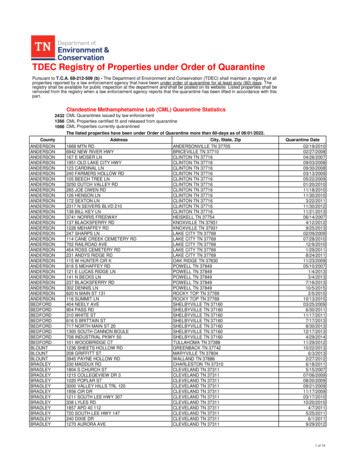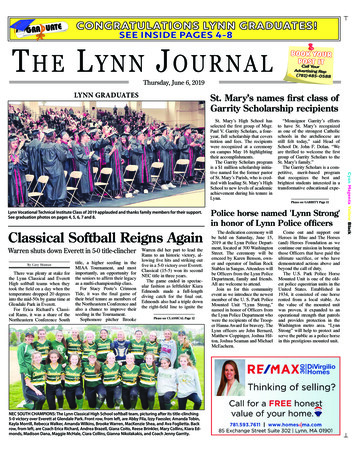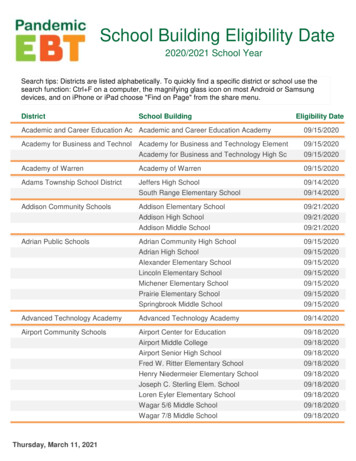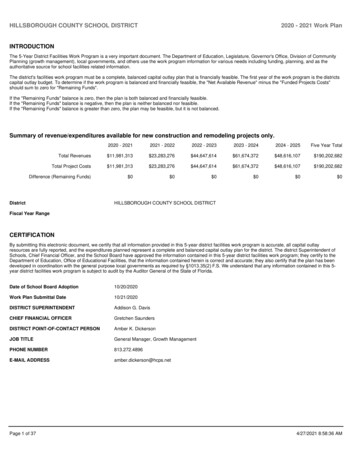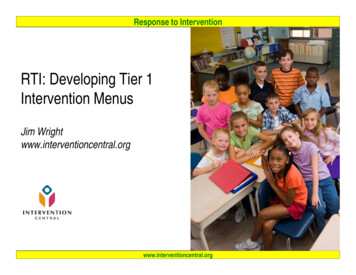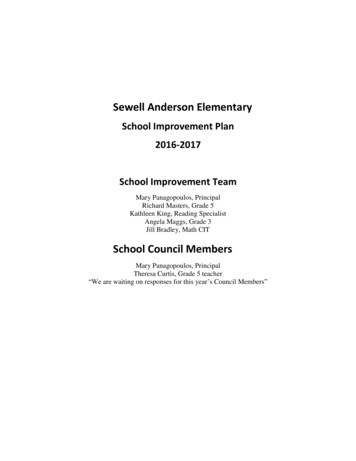
Transcription
Sewell Anderson ElementarySchool Improvement Plan2016-2017School Improvement TeamMary Panagopoulos, PrincipalRichard Masters, Grade 5Kathleen King, Reading SpecialistAngela Maggs, Grade 3Jill Bradley, Math CITSchool Council MembersMary Panagopoulos, PrincipalTheresa Curtis, Grade 5 teacher“We are waiting on responses for this year’s Council Members”
Sewell- Anderson Elementary School2016-2017 School Improvement PlanSchool Vision and MissionLynn Public School’s Vision:All Lynn students will graduate from high school with the skills to make informed choices and pursue further learningas socially responsible citizens.Lynn Public School’s Mission:To continuously improve students’ social, cultural, and academic achievement and provide all students with the skills,knowledge and experiences to achieve our vision.The Sewell-Anderson School is committed to providing high quality, developmentally appropriate, standardsbased child-centered activities within a well-equipped, organized setting. We believe supporting a child’s healthydevelopment provides the basis for academic success, and promotes the foundation for becoming life-long learners.Recognizing parents as their child’s first, most important, and longest lasting teacher, we foster a parent/teacherpartnership, and maintain communication with families about their child’s progress. Teachers provide high qualitystandards-based instruction, across all domains. As our students begin their journey of becoming life-long learners, ouroverarching goal is to develop life skills that will set them on their way.Narrative Description of the SchoolDemographic Data: Include a description of the student population (subgroup status, enrollment history, attendance),administrative staff, teaching staff (including years of service, attendance, and recruitment of highly qualified teachers), and theorganization of the school.Sewell-Anderson Elementary School is one of Lynn’s seventeen elementary schools. It has been a level 1 school for 4consecutive years, recognized as a National Blue Ribbon School and a Massachusetts Commendation School. With astudent population of approximately 284 students, the school services Kindergarten to Grade 5. The classes arecomprised of regular education and four self-contained Special Education classrooms. Sewell-Anderson is a Title Ischool.The student population is almost evenly split between male and female; 52% male and 48% female. The percentage ofstudents whose First language is not English, Economically Disadvantaged, and Special Education are higher than thatof the state (see chart below). The student population that does not speak English as a first language is approximately32%; Economically Disadvantaged is 34.6%; students receiving Special Education services is 23.5%. Regardless ofthese statistics our attendance rate has remained higher than both District and State.Student EnrollmentTeacher 0341,092Grade 15850491,356Grade 24758471,422Grade 35439561,334Grade 44558331,267Grade Staff Age201420152016Under 2626-56Over 56Median YrsExperience% %72%21%2016State6%76%18%-18-76%2
Sewell- Anderson Elementary School2016-2017 School Improvement PlanPerformance Indicators201320142015District 2015State 2015Student Attendance Rate95.695.295.193.994.9Absent 10 or more days (%)29.434.132.638.130.5Chronically Absent (% with 90%)6.69.510.919.612.3Student Retention Rate2.32.42.13.21.5Out-of-School Suspension Rate2.14.32.38.12.9Percent of students by race and gender% of Students20162014 2015 2016 DistrictAfricanAmerican8.7 10.4 ate8.8Enrollment by Special PopulationDemographic2014 2015 2016GroupFirst LanguageNot 7.027.4The staff of the Sewell-Anderson School is comprised of 23 full-time educators including 1 Principal, 1 Math CIT, 1ELL Specialist, 2 Reading Specialists, 12 teachers, 2 Specialized inclusion teachers, and 4 self-contained specialeducation teachers along with 8 part time specialists. All educators are certified and highly qualified in their contentarea. 87% of the educators in the building have professional status.Provide instruction by highly qualified teachers.The Lynn Public Schools maintains records on each one of our teacher’s highly qualified status, using federalHQ criteria. The Assistant Director of Curriculum meets with any teacher on our staff who is not qualified to create aplan for achieving this status. Assistance is provided to teachers who need to take MTELs.3
Sewell- Anderson Elementary School2016-2017 School Improvement PlanSchool Processes Data: Include a description of the implementation of the core instructional programs for all students,students with disabilities, and English language learners and the intervention strategies designed to address the needs of atrisk students. In addition, provide information about any other initiatives being implemented in regards to curriculum,instruction, assessment, professional development, and school culture.The Sewell-Anderson Elementary School has implemented a number of programs as well as interventions tomeet the needs of all learners. Teachers are regularly differentiating instruction for all learners for EnglishLanguage Learners and Students with Disabilities. Curriculum and instruction focuses have included: Reading Comprehension strategies are explicitly taught. The majority of teachers have takenprofessional development in 6 Traits of Writing and Reach for Reading. Common language is usedacross grade levels to provide a connection among students. All teachers collaborate duringProfessional Learning Time for 90 minutes twice a month. The School Support Team meets monthlywith new teachers and spends some of their time introducing and educating new teachers on schoolwide initiatives. Formative Assessment is used in classrooms. Small group instruction in all grade levels has been implemented to better address the needs ofindividual students. Classroom teachers as well as the Math CIT, ESL, Resource, and Reading teachers,use an inclusive model to provide tiered instruction. New curriculum has been implemented across all grade levels: Go Math, Reach for Reading, 6 Traits ofWriting, Anchor Comprehension, and LPS Science units.In an effort to support the whole child, the Sewell-Anderson School has focused on engaging parents andsupporting the social/emotional/ health needs through the following: Playworks recess model was a district initiative. The Playworks goal is that all students are moving andparticipating in an activity during recess.All students receive Nutrition education 4 sessions a year.The Lynn Fire Department provides Fire Safety to third grade students.Walk to School Wednesdays encourages families to meet at Gallagher Park and walk as a communityto school once a week.Create strategies to attract highly qualified teachersOur school is advised by the Lynn Public Schools’ Human Resources Office when teaching positions becomeavailable at the school. Resumes are forwarded from their office with the credentials of all teaching applicants. TheHuman Resources Office, in concert with the Assistant Director of Curriculum for Teaching Quality work toidentify teachers who are highly qualified in terms of credentials and who aspire to serve youths in a large, urbancommunity with many challenges.Recruitment fairs, advertising, and contacts with local schools of education are utilized as a way in which to locateteachers. In addition, the district has implemented processes and procedures for student teachers, which has resultedin a number of subsequent teaching hires at our school. Collaborative programs with Salem State, NortheastConsortium for Staff Development and several planned coop programs with Endicott College are easily accessed byteachers who are earning credentials. Furthermore, the district provides tutoring for any professional seeking to passMTELsTeacher EvaluationAll of our teachers are evaluated using the Massachusetts Educator Evaluation System. Teachers who might be “inneed of improvement” are monitored as they work towards improving their instruction. Curriculum and instructionteachers, math and ELA coaches, and ESL coaches work to model lessons for teachers who need to improve.4
Sewell- Anderson Elementary School2016-2017 School Improvement PlanCoordinate and integrate Federal, State, and local services and programs; and meet intent and purposes of eachprogram whose funds are consolidated, if applicableOur school submits budget requests directly to the Superintendent’s Senior Leadership team. This teamincludes both Deputy Superintendents, the Executive Director of Curriculum, the ELL coordinator, the SPEDadministrator, the human resources manager, and the financial manager for the Lynn Public Schools. As theorganization is formed and resources are allocated, all sources of funds are coordinated in order to meet the needs ofour school,Perception Data: Provide any formal or informal information regarding the perception of the school’s learning environment bydistrict and school leaders, students, teachers, parents and community members.According to the results of the Vista Survey: 52% of our teachers believe they offer opportunities for students to express their understanding beyondtraditional means. 76% of our teachers do not believe we provide enough opportunities to undertake long term projects. 84% of our faculty believe District assessment provide useful information about how well students masterthe state standards. 92% of our faculty believes analyzing data helps to improve their instruction and individualize studentlearning.5
Sewell- Anderson Elementary School2016-2017 School Improvement PlanStudent Learning Data: Provide a summary of the achievement trends of the school. Include information about studentproficiency on MCAS and accountability data (i.e., CPI, student growth percentiles, and graduation and dropout rates)Sewell-Anderson has been a Level 1 school since 2012. Sewell-Anderson has narrowed the proficiency gap in ELA. The male subgroup has exceeded the State goal of 51% in SGP in ELA (65). The female subgroup has exceeded the State goal of 51% in SGP in both ELA (58.5) and Math (54). In ELA, grade 3, there has been an increase in CPI from 84.3% to 91.8%. In ELA, grade 4 had a slight decrease in CPI from 89.3% to 88.3%. In ELA, grade 5, there has been an increase in CPI from 90% to 96.2%. In ELA, the students in grade 4 maintained an SGP of 67%. In ELA the SGP of students in grade 5 has shown an increase from 45% to 58%. In Math, grade 3 has shown a decrease in CPI from 97.1% to 93.3%. In Math, grade 4 CPI increased from 85.7% to 91.7%. In Math grade 5 CPI increased from 87.5% to 92.3%. In Math, the SGP of students in grade 4 decreased from 56% to 44%. In Math, the SGP of students in grade 5 had a significant increase from 41% to 50%. In Kindergarten, DIBELS Nonsense word fluency results showed a decrease from 93.5% (winter) to 89.1%(spring) in their overall CPI score. In First grade, DIBELS Oral reading fluency results showed a decrease from 92.7% (winter) to 87.2%(spring) in their overall CPI score. In Second grade, DIBELS Oral reading fluency results showed an increase from 82.7% (winter) to 88.5%(spring) in their overall CPI score. In Third grade, DIBELS Oral reading fluency results remained the same for SY 15-16.6
Sewell- Anderson Elementary School2016-2017 School Improvement PlanACCOUNTABILITY DATAThe state accountability system considers multiple measures of achievement in ELA, Math, and Science, as well asgrowth statistics to determine a school’s relative standing compared to similar schools in the commonwealth. Schoolsin the lowest 20% of schools with similar configurations (i.e., elementary schools, elementary/middle schools, middleschools, and high schools) are automatically identified as Level 3. Schools are identified as Level 1 or Level 2 based onwhether the school is meeting the cumulative Progress and Performance Index (PPI) target of 75.Accountability and Assistance Level: Level 1School Percentile: 63Cumulative PPI (all students) 100Proficiency ange87.787.988.20.3Above Target92.64.4Above TargetSGP676156-5On Target615.0Above Target% Advanced9.410.36.9-3.4Not meeting target8.11.2Met Target% Warning2.31.54.63.1Not meeting target1.5-1.6Met TargetCPI88.389.089.30.3Above Target92.53.2Above TargetSGP585752.5-4.5On Target49.5-3.0On Target (SH)% Advanced14.819.118.3-0.8Not meeting target25.57.2Met Target% Warning3.15.11.5-3.6Met Target1.50.0Not meeting targetCPI82.179.278.8-0.4On Target78.4-0.4No Change% Advanced15.40.02.52.5Met Target1.9-0.6Not meeting target% Warning0.04.812.57.7Not meeting target5.8-1.9Met Target2015SGPA2015Target2016SGPA2016Target81602015 Rating2016 RatingMathScienceELL ProficiencyGrowth-Met TargetHistorical Accountability Data2012 Level 1School Percentile:34th %ileAnnual PPI 120Cumulative PPI 772013 Level 1School Percentile:48th %ileAnnual PPI 110Cumulative PPI 922014 Level 1School Percentile:58th %ileAnnual PPI 105Cumulative PPI 1002015 Level 1School Percentile:60th %ileAnnual PPI 95Cumulative PPI 1002016 Level 1School Percentile:63rd %ileAnnual PPI 105Cumulative PPI 1007
Sewell- Anderson Elementary School2016-2017 School Improvement PlanEarly Literacy ResultsKindergarten: DIBELS Nonsense Word Fluency (Winter to Spring – SAME Students)Achievement LevelAbove/Well Above AvgAverageLow AverageBelow AverageWell Below AverageCPI# and % of StudentsWinter 2016Spring 201611 (48%)8 (35%)3 (13%)0 (0%)1 (4%)93.57 (30%)9 (39%)4 (17%)3 (13%)0 (0%)89.1Growth(Change in %ile)# and % of ned2 (9%)4 (17%)9 (39%)8 (35%)348 (35%)173 (18%)218 (22%)246 (25%)23985Total1st Grade: DIBELS Oral Reading Fluency (Winter to Spring – SAME students)Achievement LevelAbove/Well Above AvgAverageLow AverageBelow AverageWell Below AverageCPI# and % of StudentsWinter 2016Spring 20169 (22%)24 (59%)5 (12%)2 (5%)1 (2%)92.79 (22%)17 (41%)11 (27%)2 (5%)2 (5%)87.2Growth(Change in %ile)HighModerateTypicalLow/DeclinedTotal# and % of StudentsSchoolDistrict1 (2%)8 (20%)18 (44%)14 (34%)217 (17%)316 (25%)393 (31%)325 (26%)411,2512nd Grade: DIBELS Oral Reading Fluency (Fall to Spring – SAME students)Achievement Level# and % of StudentsFall 2015Spring 2016Growth(Change in %ile)Above/Well Above AvgAverageLow AverageBelow AverageWell Below AverageCPI14 (36%)9 (23%)8 (21%)5 (13%)3(8%)82.7HighModerateTypicalLow/Declined18 (47%)11 (28%)5 (13%)2 (5%)3 (8%)88.5Total# and % of StudentsSchoolDistrict10 (26%)11 (28%)13 (33%)15 (38%)269 (19%)375 (27%)426 (30%)331 (24%)391,4013rd Grade: DIBELS Oral Reading Fluency (Fall to Spring – SAME students)Achievement Level# and % of StudentsFall 2015Spring 2016Growth(Change in %ile)Above/Well Above AvgAverageLow AverageBelow AverageWell Below AverageCPI13 (26%)22 (44%)7 (14%)5 (10%)3 (6%)87.0HighModerateTypicalLow/Declined19 (38%)17 (34%)6 (12%)5 (10%)3 (6%)87.5Total# and % of StudentsSchoolDistrict10 (20%)11 (22%)16 (32%)13 (26%)179 (15%)283 (23%)389 (32%)363 (30%)501,2148
Sewell- Anderson Elementary School2016-2017 School Improvement PlanENGLISH LANGUAGE ARTSMulti-Year MCAS ELA Results – All Students% at Each LevelStudentsIncludedAPNIWCPISGPSchool 20121361038322084.654School 2013128942301987.767School 20141361040321887.961School 2015131752212088.256School 2016136860151692.661District 20167,581747311581.054Student GroupMulti -Year MCAS ELA CPI Results by GRADEMulti -Year MCAS ELA SGP Results by GRADESGP by GradeCPI by Grade80100906080407020122013201420152016Gr 383.787.886.184.391.8Gr 484.084.286.389.388.3Gr 586.091.791.790.096.22020122013201420152016Gr 44562506867Gr 56472634558PARCC / MCAS ELA 2016 Results by Subgroup% at Each LevelStudentsIncludedAPNIWAll Students13686015Students with Disabilities33018ELL7Former ELL110Economically Disadvantaged61MaleFemaleStudent 58.871655142593.06565116617692.358.59
Sewell- Anderson Elementary School2016-2017 School Improvement PlanMATHEMATICSMulti -Year MCAS Math Results – All Students% at Each LevelStudentsIncludedAPNIWSchool 2012136153427School 20131281541School 201413619School 2015131School 2016District 2016Student 9.352.51372643151692.549.57,5461534302174.650Multi -Year MCAS MATH CPI Results by GRADEMulti -Year MCAS MATH SGP Results by GRADESGP by GradeCPI by Grade10080906080407020122013201420152016Gr 386.495.387.097.193.320122013201420152016Gr 482.484.290.685.791.7Gr 46659.5435644Gr 583.785.389.987.592.3Gr 5715469415020PARCC / MCAS Math 2016 Results by Subgroup% at Each LevelStudentsIncludedAPNIWAll Students137264315Students with Disabilities33024ELL7Former ELL1118Economically Disadvantaged61MaleFemaleStudent 91.849.5722140152492.435.565314615892.75410
Sewell- Anderson Elementary School2016-2017 School Improvement PlanSCIENCE/TECHNOLOGY & ENGINEERINGMulti -Year MCAS STE Results – All Students% at Each LevelStudentsIncludedAPNIWSchool 201243930372373.3School 2013391515462382.1School 201442033452179.2School 201540238352579.4School 201652223443178.4District 2016 (Grade 5)1,044927451872.7State 2016 (Grade 5)69,6811631381476.4Student GroupCPIMCAS STE 2016 Results by SubgroupStudent GroupStudentsIncluded% at Each LevelCPIAPNIWAll Students52223443178.4Students with Disabilities1800287286.1ELL1Former ELL3Economically 5428482076.011
Sewell- Anderson Elementary School2016-2017 School Improvement PlanACCESS for ELLs 3-Year Results on Overall Score.2014ELL Students2015ELL Students2016ELL %Total283637ACCESS for ELLs GrowthYearHigh Growth#%Moderate Growth#%20141263%120151155%20161771%Low Growth#%5%632%315%630%417%313%ACCESS for ELLs change in proficiency level2015 ACCESSProficiency LevelsEntering2016 ACCESS Proficiency LevelsEnteringEmergingDeveloping1 (20%)4 (80%)ExpandingBridgingReaching1 (17%)Emerging3 (33%)6 (67%)Developing1 (17%)2 (33%)2 (33%)1 (20%)4 (80%)ExpandingBridgingTotal (25)12
Sewell- Anderson Elementary School2016-2017 School Improvement PlanNeeds Assessment- Curriculum and Instruction (Refer to Conditions for School Effectiveness III and IV)Using state, local, and classroom assessment data, identify specific areas of strength and need in the Curriculum andInstruction areas listed below. Consider and analyze student results by grade-level, subgroups, learningstandards/strands/domains, question type, etc. The curricula and instructional practices in the school are developed andimplemented to attain high levels of achievement for all students.Indicator 1: Aligned and Consistently Delivered Curriculum: School leadership, teachers and other staff ensure consistent useand effective delivery of the district’s curricula/mapping. The school’s taught curricula are aligned to state curriculumframeworks and are also aligned vertically between grades and horizontally across classrooms at the same grade level andacross sections of the same course.Strengths: Teachers follow the district map and pacing guides to develop standards-based lesson plans. With assistance from support staff and classroom teachers, tiered instruction is implemented inELA. Small group instruction is consistently executed in ELA on a weekly basis PLT time has increased collaboration between all teachers within grade levelsAreas of Need: Professional Development with new curriculum Professional Development on implementation of small group instruction in Math School wide implementation of the writing programIndicator 2: Effective Instruction: Instructional practices are based on evidence from a body of high quality research and onhigh expectations for all students. The school staff has a common understanding of high-quality evidence-based instructionand a system for monitoring instructional practice.Strengths: K-2 teachers have received PD in Reach for Reading and are implementing district pacing guides Use current data to target at-risk students for additional support Small group instruction is consistently executed in ELA.Areas of Need: Professional development in the new ELA curriculum for SY16-17 Grades 3-5. Staff would benefit from professional development in higher order thinking skills (HOTS). Staff would benefit from professional development in technology (ie. iPads, SMARTboards,computers). Small group instruction needs to be increased in Math.13
Sewell- Anderson Elementary School2016-2017 School Improvement PlanNeeds Assessment- Assessment (Refer to Conditions for School Effectiveness V)School leadership, teachers and other staff use student assessment results (formative, benchmark, state assessments) externaland internal reviews, and other pertinent data to improve student achievement and inform all aspects of its decision-makingincluding: professional development, student services, instructional programs, and assessment practices.Indicator 3: Data-based Decision-Making: The school analyzes and uses data to drive decision-making. School leadership,teachers and other staff review student assessment results, external and internal reviews, and other pertinent data toprioritize goals, maximize effectiveness in allocating resources and to initiate, modify or discontinue programs, policies andinitiatives.Strengths: Data-based tiered instruction – teachers drive instruction based on District assessment data(District: DIBELS, DAZE, MCAS, Unit Assessments). Sharing data findings with staff during Faculty Meetings. Through progress monitoring teachers are able to track students’ progress. Teachers receive a profile of students that are serviced with an IEP or 504. Based on MCAS data students are invited to an Extended Learning Time program. Teachers are provided with data reports from TestWiz (Math) and Ideal (ELA) to drive instruction.Areas of need: Formative assessments need to be used regularly to drive small group instruction. (i.e lessonsummarizers). Classroom teachers lack awareness of ELL standards (i.e. MPIs).Needs Assessment- Professional Learning (Refer to Conditions for School Effectiveness VII)Describe the process of determining the professional learning needs of all staff, including how the school implements ongoingprofessional development during the school year. Professional development programs and services are based on district andschool priorities, information about staff needs, student achievement data and assessments of instructional practices andprograms.Indicator 4: Professional Development: PD for school staff includes both individually pursued activities and school-based, jobembedded approaches, such as instructional coaching. It also includes content-oriented learning.Strengths: Professional development in Reach for Reading, RETELL, Go Math, Six Traits of Writing, andRBT. Ongoing collaboration and mentoring among staff members throughout the entire school year Professional Learning Time occurs biweekly for all staff membersAreas of need: Professional development in Technology Professional development in differentiation within small group instruction Peer Observations Guest speakers at staff meetings to discuss current topics in education (LPS related, state initiatives,etc.)14
Sewell- Anderson Elementary School2016-2017 School Improvement PlanIndicator 5: Structures for Collaboration: The school has structures for regular, frequent collaboration to improveimplementation of the curriculum and instructional practice. Professional development and structures for collaboration areevaluated for their effect on raising student achievement.Strengths: Collaboration between teachers and specialists to analyze data to drive instruction Professional Learning Time (1 x 90 minutes bi-weekly)-Administrative driven with a focus on data,professional development, and school processes. Faculty Meetings (1x monthly) School Support Meetings (New Teachers and Mentors) to share school initiatives Special Education meetings focusing on MCAS-ALTAreas of need: Vertical alignment – there needs to be an understanding of the curriculum in previous andsubsequent grades. All teachers should have the opportunity to participate in Learning Walks throughout the schoolyear.Needs Assessment- Student Support (Refer to Conditions for School Effectiveness VIII, IX and X)Schools have a framework for providing appropriate supports (academic, social, emotional, and health) to all students. Schoolleadership, teachers and other staff engage with families and community partners to promote student achievement andprogress.Indicator 6: Tiered Instruction and Adequate Learning Time: The school schedule is designed to provide adequate learningtime for all students in core subjects. For students not yet on track to proficiency in English language arts or mathematics, theschool provides additional time and support for individualized instruction through tiered instruction, a data-driven approach toprevention, early detection, and support for students who experience learning or behavioral challenges, including but notlimited to students with disabilities and English language learners.Strengths: An inclusion model is utilized successfully throughout the building with the use of Resourcespecialists. Students from DD and II classrooms have the opportunity to mainstream into a least restrictiveenvironment whenever possible. Student Study Team meets on a monthly basis. 504 coordinator works with District compliance officer. A progress-monitoring system is in place in ELA; data from this system drives instructionaldecisions throughout the tiered process. Contractual extra-help used to support high needs students (before and after school). Afterschool programs in both ELA and Math based on MCAS data. Reading specialists provided enrichment to students. Imagine Learning for ELL students and substantially separate students.Areas of need: Using formative assessments to address the students in need15
Sewell- Anderson Elementary School2016-2017 School Improvement PlanIndicator 7: Students’ social, emotional, and health needs: The school creates a safe school environment and makes effectiveuse of a system for addressing the social, emotional, and health needs of its students.Strengths: The school is provided with a Bullying Coordinator, Playworks Coordinator, School AdjustmentCounselor, Homeless Coordinator, and Behavior Specialist. Schoolyard is monitored each morning before school by staff members, this allows students to playsafely Students recite a daily School Pledge to build community. Multiple programs are offered to our students. i.e. Forsythe Dental, Fire safety program, Eye andEar testing, Nutrition, Walk to School Wednesday, Pedestrian and Bike Safety. Many extra-curricular activities are offered throughout the school year. A school-wide procedure for discipline has been established. Full-time school nurse who diligently addresses social/emotional needs of the Sewell AndersoncommunityAreas of need: Students would benefit from an increase of availability from SAC services and behavior specialists. More opportunities to participate in Safety Care training School social workerIndicator 8: Family-school and Community engagement: The school develops strong working relationships with families andappropriate community partners and providers in order to support students’ academic progress and social and emotional wellbeing.Strengths: Communications between school and family include: Principal monthly newsletter, SchoolCalendar, Take home Tuesday Parent involvement series Many opportunities given to school and family to socialize: PTO activities and fundraisers, Walk toschool Wednesdays, Monthly Assemblies, and Faculty basketball School has a strong partnership with the Rotary Club and Shaw’s Supermarkets. Active PTOAreas of need: Update Sewell-Anderson School website and Facebook page. Implementation of School CouncilNeeds Assessment- Leadership (Refer to Conditions for School Effectiveness II)Effective School leadership. The school takes action to attract, develop, and retain an effective school leadership team thatobtains staff commitment to improving student learning and implements a clearly defined mission/vision and set of goals.Clear systems, structures, and procedures guide daily routines and school programs.Indicator 9: School leaders convey clear, high expectations for all stakeholders and ensure that the school-wide focusremains on established academic goals and school priorities. Communication between the leadership team and staff isfluid, frequent, and open to ensure an inclusive, transparent decision-making across the organization.Strengths: Reading Specialist and Math CIT conduct weekly PLT meetings Principal has an open door policy for staff, students, and parents Principal communicates data to all staff membersAreas of need: Compensation for Leadership Team meetings afterschool Staff members share their expertise and knowledge at staff meetings16
Sewell- Anderson Elementary School2016-2017 School Improvement PlanDefine Priorities and Describe the Strategies/ActionsDefine Priorities for School Improvement that have been identified as a result of the Needs Assessment. Name anddescr
The staff of the Sewell-Anderson School is comprised of 23 full-time educators including 1 Principal, 1 Math CIT, 1 ELL Specialist, 2 Reading Specialists, 12 teachers, 2 Specialized inclusion teachers, and 4 self-contained s pecial education teachers along with 8 part time specialists. All educators are certified and highly qual ified in their .

